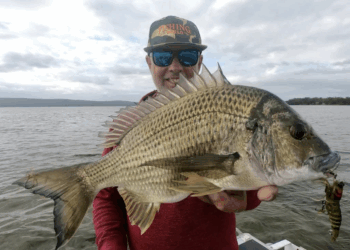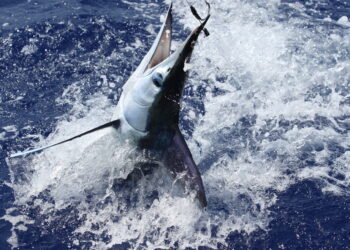Targeting SA’s Bluefin Run
The resurgence of southern bluefin tuna has given SA-based fishos a chance at champagne sportfishing. JAMIE CRAWFORD explains how to get amongst it this season.
THE summer months herald the long-awaited arrival of southern bluefin tuna into South Australian waters. Our southern winters can be harsh for blue water enthusiasts, but when the current lines arrive and schools of SBTs begin to show in the Bight, those dreary winter days are forgotten as lures and tackle are readied for a new season.
These schools of bluefin are moving east and, depending on the season, will only hold in one area for a short length of time. The past two seasons have been blinders on these schooling bluefin, with good numbers of fish visiting our offshore islands and reefs for upwards of two to three months before venturing further east.
These blueys aren’t the keg-class barrels found in other parts of the country, but rather school sized fish in the 8-20kg bracket. The occasional 40kg fish makes an appearance, but the majority average 15kg. This makes them a fun class of fish, especially on light to medium game outfits.

For the southern sport fisho there’s nothing more welcoming than the sight of bombing terns and gannets in our offshore waters. When a patch of feeding SBTs are located, multiple hook-ups are the norm rather than the exception. And with high-speed bursts of energy and rhythmic broad-side circling, bluefin tuna are an exciting southern sportfish – they slug it out all the way to the boat.
Mixed in with the southern bluefin tuna are occasional schools of albacore. In our state’s western waters, the albacore are generally small fish of less than 10kg, but along SA’s south-eastern coastline some thumping 20kg albies are taken.
Where & When
Schools of bluefin begin crossing the WA border and into SA waters during November, with the remote Bight outpost of Fowlers Bay first in line for some tuna action. The bluefin start to arrive on the lumps wide of Fowlers during December, with Christmas time through to the middle of January being the peak period.
The bluefin at Fowlers come within two to three miles of the bay, but are more regularly found several miles offshore, especially towards Nuyts Reef. There is beach launching access next to the township, but these are the most remote waters in South Australia so obvious caution should be heeded.

The grounds wide of Streaky Bay and Sceales Bay are the next stopover for these migrating blues. They start to appear on these lumps from December onwards, with January the peak month. Sceales is a consistent producer of these summertime pelagics, with the charted lumps 12 miles wide of the bay holding baitfish and tuna up until the end of March.
Local charter operator Matt Guidera was still catching tuna throughout May last season; such was the good run of fish. There is a concrete ramp at Streaky, but it’s a long run to the tuna grounds from here. Sceales has a concrete slab leading onto the beach, but it’s primarily a beach launch.
As schools of fish continue to push westward, they pass by the islands wide of Elliston. This remote cluster of islands, known as the Investigator Group, sees bluefin frequenting the outer islands, namely Pearson and Ward, from the end of December until February. These islands lay around 35 miles offshore, and are strictly big boat country.
Next in line are the deepwater lumps wide of Coffin Bay, which are the gun trailerboat tuna grounds on the west coast. It’s still a fair trek to reach these productive reefs and islands, but with the stable weather conditions of autumn coinciding with this annual run of bluefin, quite a few trailerboats delve into this hot sport fishery.

From the concrete ramp at the Coffin Bay township, it’s a 20 mile run to Point Sir Isaac. Although pods of tuna visit Point Sir Isaac, a further 25 miles to Greenly Island will greatly improve your chances of finding some bluefin. If you don’t mind launching from the sand, then Farm Beach will knock 10 miles off the journey to Greenly Island, making it a 35 mile one-way trip.
Another beach launch, this time from Avoid Bay, gives access to the four Hummocks, a 17-mile journey one way, and Rocky Island, a 32-mile journey. Both of these grounds turn on fantastic tuna fishing from February through until the end of April. The average size is 12–17kg, and the number of schools actively feeding can be impressive – an encouraging sight indeed.
Port Lincoln is the next destination on the bluefin’s program. Port Lincoln is famous for SBTs, with a bustling tuna industry still active from this southern port. The Tunarama festival held annually in January honours the tuna industry of past and present, and celebrates the start of a new tuna season. And while schools of bluefin frequented Port Lincoln’s inshore waters in days gone by, the fish are only found around the offshore islands and reefs these days.
The Cabbage Patch is the most consistent tuna ground in close proximity to Lincoln, but with an 80 mile round trip it’s rarely visited by trailer boats. Quite a few 20–25kg fish are taken from the Patch, with a few kingfish rising from the massive mount to swipe passing lures. Williams Island, West Point and the Neptune Islands all produce tuna when the schools are active. The bluefin visit these waters from late January through until April.
As the fish continue to follow the warm current-lines, they pass by the southern coastline of Kangaroo Island. Charter boats working the offshore waters from Vivonne Bay to Cape Borda encounter tuna schools from March to May. This is a hit-or-miss tuna fishery though, and should probably be left for the charter guys.
The continental shelf in the south-east is the final stopover for the bluefin before they cross the border into Victoria. Port MacDonnell is the recognised tuna town in the south-east, with the fishing at its peak during May and June. Schools of fish are found between 20 to 25 miles wide of Port Mac, with some scattered patches of fish venturing to within several miles from shore when the season’s in full-swing.
The average size in the south-east is much the same as our western waters, with 8–20kg fish the norm. However, a handful of 50–80kg beasts have been taken over the past few seasons – no doubt this plays on the mind when trolling a spread of 8 to 10kg outfits!
Tackle & Technique
A typical tuna trolling outfit for SA comprises a mid-sized overhead, such as a TLD 15 or equivalent, coupled to a 15-24kg stroker. I prefer fishing 10 or 15kg mono as a mainline, with lures tracking better on mono than on braided or GSP lines – tending not to break the surface on those sloppy days. Wind-on leaders of 80 to 100 pound are great when tracing a bluefin in the dying stages of a fight.
Most recognised bluewater lures will work on our feisty southern bluefin. I tend towards smaller diving minnows, such as Rapala CD-11s and CD-14s, with a preference for the green mackerel pattern. The 120mm Halco Laser Pros are another gun offshore diver, and track beautifully through the water.
We troll our diving minnows at around 6-8 knots, with a four-rod spread using outriggers giving more than enough lures in the water. When a school of surface feeding bluefin are spotted on the horizon, it’s not a case of “will they strike”, but more “how many lures will they strike”. Double and triple hook-ups are entertaining, but a four-way hook-up from a trailerboat can be chaotic …

After a few successful passes of a feeding school, the tuna can be flighty and often retreat to the depths. To avoid this, always troll on the edge of the feeding activity, never through the guts of the action. Keeping distance from the school and firing metal slugs at the feeding fish is a good way of getting a hook-up without spooking the whole school.
A 6’5” to 7’0” spinning rod rated at 10 to 15kg matched with an 8000–10000 threadline makes for a dynamite combo for flicking metal slugs at surface-feeding bluefin. Running 30lb braid promises an intense fight with these bullocking blues, but remember to use a wind-on or shock-leader of 60 to 80 pound trace to absorb some of the impact.
Another means of holding fish on the surface is to have a bucket of pilchards at the ready, as hooked fish often have mates trailing behind. These following fish can be tempted with a handful of pillies, and when a patch of fish is taking berley behind the boat, it’s a simple case of floating some baits down the trail.
When a school of fish are showing on the sounder, but not playing the game on the surface, anchoring up-current of the sounding and creating a berley trail can be an effective way of tempting fish holding deep. We like to create a continual trail of chopped pilchards, and then float a couple baits down the trail. It’s not that dissimilar to cubing for yellowfin on the east coast, except a five-tonne patch of bluefin is often holding nonchalantly below the boat. Some of our best bluefin have come from using this technique.
On those sloppy days where spotting tuna on the surface is near impossible, covering ground is the only option to locate some fish. We opt for high speed lures such as 10–14cm bullet-head skirted lures in dark colours such as blues and purples. By using these lures we can troll at 10–12 knots and cover considerable distance. If we have access to a sea surface temperature chart, we will troll along likely temperature troughs; otherwise we will troll along the edge of contour lines and reefs.
Being a high oxygen demanding fish, tuna don’t cope with being out of water for long. If a fish is intended for release, hold the tuna in a knotless net such as an Environet, but do not try to lift the fish free of the water. Instead remove any hooks or trace line with the fish still pumping water through its gills. This will ensure released bluefin are in good condition.
As a table fish, bluefin tuna are fantastic … when fresh. They don’t freeze well in conventional household freezers (the commercial snap-freezers for sushi-grade bluefin are -60 C).
But some freshly marinated tuna steaks seared on the hot-plate is up there for me. Bring on the bluefin!


















